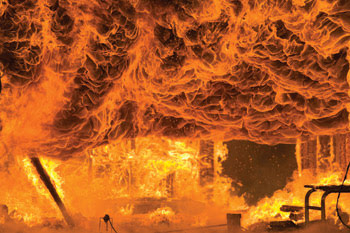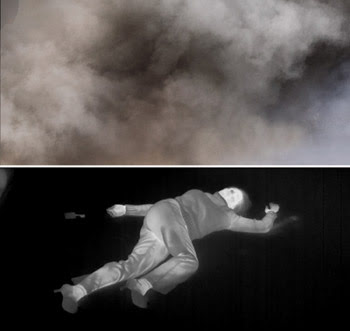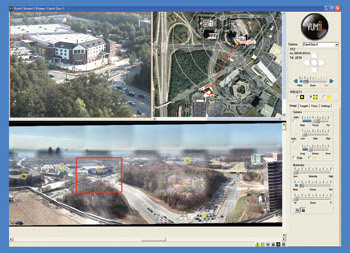Specialized photonics-based tools detect dangers and protect work sites.
The factory floor hums with human and mechanical activity. Industrial robots weld steel, conveyors move parts, cameras scan inventory, and lasers mark pieces prior to assembly into a final product. Trays of parts feed into the processing floor, and crates of ready-to-ship products make their way toward the exit. Workers flit about keeping production going and solving any problems that come up. All runs smoothly – until an alarm shrieks for attention.

In manufacturing plants all over the world, there lurks the real possibility that a dangerous situation will arise. Chemical spills and fires are among the most common threats to worker safety, and security threats, such as from intruders or disgruntled employees, also loom. Flooding resulting from storms like hurricanes Katrina or Ike – or to more mundane events, like broken plumbing – can lead to mold and, hence, to respiratory issues. And these events happen not just in factories but in any workplace. Laboratories, mills, office buildings, shopping centers – even tractor-trailers and taxicabs – can be hazardous places to be when things go wrong.
A view from the inferno
It almost goes without saying that firefighters have one of the toughest, most dangerous jobs on the planet. Putting out fires is just one part of their job, however. They also spend a great deal of time inspecting office buildings and industrial facilities for fire hazards. And when a fire does engulf a building, they also are prepared to enter the site to look for victims.
When a team of firefighters starts a search and rescue mission inside a burning building, the flames and crumbling structure aren’t the only problems. To find people who may be trapped – or worse, lying unconscious on the floor – the group must deal with a blinding amount of smoke.
In smoke-filled spaces, firefighters typically have coped with almost nonexistent visibility by crawling on the floor and sticking to a prescribed pattern of movement, as if the site were a maze from which to escape. More recently, fire squads have begun turning to thermal imagers – cameras that record images in the infrared range. Modern infrared cameras can sense temperature differences to within 0.1 °C, enabling their use in search and rescue operations as well as in fire prevention, analysis of hot spots and arson investigations.

In a dark, smoke-filled room (above), firefighters have no chance of finding survivors and victims except by touch. With a thermal imager, visible light doesn’t matter – only variances in temperature, such as the heat energy emitted by a victim’s body (right). Courtesy of Flir Systems Inc.
Bill Klink, vice president of security and surveillance at Flir Systems Inc., says that thermal imagers are useful whenever visibility is near zero. “Their biggest value is that they see through smoke. Firefighters use them in smoke-filled rooms to look for people or for hot spots.”
Firefighters can carry cameras directly into dangerous sites, but fixed cameras also can be installed in places where the risk of a fire may be more prevalent or where population density in a building is high, so that security personnel can monitor people’s locations should a smoky fire break out. For example, Flir has a fixed-mount infrared camera installed at Norfolk County Jail in Virginia for this purpose.
According to Klink, thermal imagers are getting smaller and may one day be mounted on firefighters’ helmets. He also wouldn’t be surprised to see the devices continue to shrink in size and their production to increase in volume so much that they eventually become integrated into cell phones.
Gasping for air
Smoke and flames aren’t the only hazards faced by firefighters and other emergency personnel. Toxic materials – such as leaked or spilled chemicals – are a direct threat to the lives of workers and of the responders. Carbon monoxide, carbon dioxide, chlorine, ammonia, hydrogen sulfide and volatile organic compounds comprise the bulk of dangerous chemicals that must be identified quickly and safely before they can be treated or removed.
Spectrometers are the standard instrument for testing the composition of unknown materials, but they have tended to be large, bulky, expensive and difficult to decipher without a PhD in chemistry. For the past several years, however, intensive efforts have been under way to simplify the mechanisms of spectrometers, to shrink them to handheld size and to make them affordable enough to get into the hands of firefighters, hazmat personnel, drug enforcement agents and even forensics teams
One type of spectrometry, known as nondispersive infrared sensing, is commonly used to identify CO2 or H2S in the atmosphere. In the technique, air is drawn across the sensor and a tiny infrared light source irradiates the molecules in the gas. The amount of light absorbed at the wavelength emitted provides information about the presence and concentration of the toxins in the air.

Vumii Inc.’s Discoverii camera system, used here with the company’s Sensorii software, employs infrared light from a continuous-wave laser to illuminate people, vehicles and buildings with nearly visible-light contrast. As seen in the upper right image, data captured with the infrared system can be combined with radar data. Courtesy of Vumii Inc.
According to Bob Durstenfeld of RAE Systems Inc. in San Jose, Calif., nondispersive IR sensors are small and cost-effective tools for use by hazmat team members and first responders.
Another popular type of sensor is the photoionization detector, or PID, which uses ultraviolet radiation to remove electrons from a suspect material, thus giving it a charge that can be measured. The amount of charge tells how much of the material – typically in solution – is present. Durstenfeld said that PIDs are RAE Systems’ best selling product, used extensively by petrochemical producers and processors to search for problems with pipes, tanks and other confined spaces filled with such toxins as plastics, solvents and their precursors, such as benzene.
Smiths Detection and GE Security Inc. are among a number of other companies that have directed an increasing amount of attention to materials identification. Among Smiths Detection’s most recent offerings is the HazMatID Ranger, a point-and-shoot spectrometer that can be operated by hand or remotely via a Bluetooth-enabled PDA. GE Security, on the other hand, recently announced StreetLab Mobile, another handheld device, but one that uses Raman spectroscopy to detect and identify toxic, narcotic or otherwise dangerous substances.
Threats from without
Threats to lives, buildings and equipment don’t just come from inside a structure. Offices, factories and other workplaces must be protected from people who mean physical harm or who intend to steal or damage goods or equipment.
Most facilities have security features designed to prevent unauthorized access via coded doorways or radio-frequency devices built into ID badges. Others use cameras that enable security personnel to individually screen people who wish to enter restricted areas. However, facilities that process highly volatile goods, such as petrochemicals, or that contain materials that are highly dangerous if released, such as nuclear energy plants, must push security measures to the limits of their borders. The goal is to keep intruders as far away as possible at all times.
Because sneaking onto the grounds of a facility is best accomplished after nightfall, the gold standard for intruder detection has been the use of thermal imagers. But even though spotting a potential trespasser by his thermal signature is useful, it may not provide all of the information one needs to deal with him – is he carrying a weapon, for example, or is he maybe a legitimate employee just wandering the grounds?
Atlanta-based Vumii Inc. addresses this potential disadvantage by eschewing thermal imaging. Staying in the infrared realm, however, the company favors continuous-wave laser illumination to provide camera-based detection systems that can show targets in full contrast, including facial features, insignia on clothing, and license plate numbers or other vehicle identification.
The Discoverii systems made by the company dynamically slave an ~850-nm continuous-wave laser to a 640 × 480-pixel CCD camera with a zoom lens. When the camera is being operated, the laser’s spot size changes from about 5 mrad to 10° with the field of view. The cameras have an effective range of 5000 m.
“The energy spectrum the system operates within produces a natural contrast image similar to the visible spectrum, just without color,” said Miky Tamir, chief technology officer of Vumii. “So, faces, words, patterns and textures are all apparent.”
Besides petrochemical facilities, Vumii sells the laser-based systems to airports, seaports, police departments (for intracity surveillance) and military bases, according to Tamir.
Future protection
Companies like Vumii, RAE Systems and others are working to extend the capabilities of their current technologies. Spectrometers will continue to shrink and perhaps become as ubiquitous as fire extinguishers in factories. Infrared and other wavelengths will drive imaging techniques designed to forestall fires, chemical hazards and intruders. But that is not all that the future holds in store.
Commercial and academic enterprises are striving toward advanced health and safety tools. Someday, specialized guards and lockout mechanisms may prevent accidents via machine vision equipment designed to judge a worker’s motions and momentum near machinery or active lasers. Brain-imaging devices may scan workers and visitors alike as they enter buildings, and artificial intelligence could use the images to decide whether the person is drunk, overdosed or intent on violence. Robotic camera systems may evaluate workers for ergonomic issues and communicate with smart chairs, workbenches or other furniture to ensure an individual’s best posture.